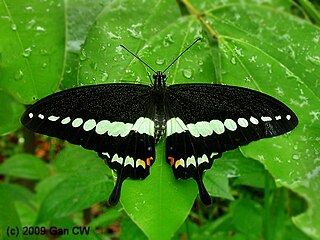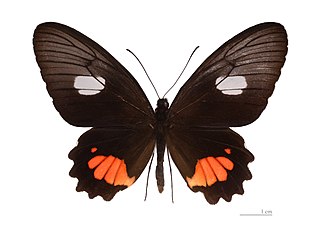
Acraea terpsicore, the tawny coster, is a small, 53–64 millimetres (2.1–2.5 in), leathery-winged butterfly common in grassland and scrub habitats. It belongs to the Nymphalidae or brush-footed butterfly family. It has a weak fluttery flight. It is avoided by most insect predators. This species and the yellow coster are the only two Indian representatives of the predominantly African tribe Acraeini. It is found in India, Sri Lanka, Indonesia, Maldives to Myanmar, Thailand, Laos, Cambodia, Vietnam, Bangladesh, Malaysia, Singapore, and recently Australia.

Ornithoptera goliath, the Goliath birdwing, is a birdwing butterfly found in New Guinea. It is the second largest butterfly in the world, after the Queen Alexandra's birdwing.

Eurema hecabe, the common grass yellow, is a small pierid butterfly species found in Asia, Africa and Australia. They are found flying close to the ground and are found in open grass and scrub habitats. It is simply known as "the grass yellow" in parts of its range; the general term otherwise refers to the entire genus Eurema.

Graphium antiphates, The Five-bar swordtail or the green black-striped giant jay is a species of papilionid butterfly found in South and Southeast Asia. The species was first described by Pieter Cramer in 1775.

Hypolimnas bolina, the great eggfly, common eggfly, varied eggfly, or in New Zealand the blue moon butterfly, is a species of nymphalid butterfly found from Madagascar to Asia and Australia.

Troides minos, the southern birdwing, also called Sahyadri birdwing, is a large and striking species of swallowtail butterfly. It is endemic to southern India. With a wingspan of 140–190 mm, it is the second largest butterfly of India. It is listed as Least Concern in the IUCN Red List.

Daphnis nerii, the oleander hawk-moth or army green moth, is a moth of the family Sphingidae. It was described by Carl Linnaeus in his 1758 10th edition of Systema Naturae.

Hypolimnas misippus, the Danaid eggfly, mimic, or diadem, is a widespread species of nymphalid butterfly. It is well known for polymorphism and mimicry. Males are blackish with distinctive white spots that are fringed in blue. Females are in multiple forms that include male-like forms while others closely resemble the toxic butterflies Danaus chrysippus and Danaus plexippus.

Papilio demolion, the banded swallowtail, is a species of swallowtail butterfly belonging to the family Papilionidae.

Ornithoptera paradisea, the paradise birdwing, is a species of birdwing butterfly found in New Guinea.

Colias palaeno, known by the common names moorland clouded yellow, palaeno sulphur, and pale Arctic clouded yellow, is a butterfly in the family Pieridae.

Cethosia biblis, the lacewing biblis or red lacewing, is a species of heliconiine butterfly belonging to the family Nymphalidae.

Trigonodes hyppasia, the triangles or semi-looper, is a moth in the family Erebidae. The species was first described by Pieter Cramer in 1779. It is largely cosmopolitan, found throughout Borneo, Fiji, India, Maldives, Nepal, Sri Lanka, São Tomé and Príncipe, Taiwan, Thailand, Zimbabwe, northern Australia, and almost all African countries.

Pergesa is a monotypic moth genus in the family Sphingidae first described by Francis Walker in 1856. Its only species, Pergesa acteus, the green pergesa hawkmoth, was described by Pieter Cramer in 1779.

Graphium policenes, the common swordtail or small striped swordtail, is a species of butterfly in the family Papilionidae (swallowtails). It is found in tropical Africa.

Parides sesostris, the emerald-patched cattleheart or southern cattleheart, is a species of butterfly in the family Papilionidae.

Parides anchises, the Anchises cattleheart, is a species of butterfly in the family Papilionidae native to the Americas. It is common and not threatened. The larvae feed on Aristolochia species including: A. brazilsis, A. bukuti, A. colombiana, A. cymbifera, A. fimbriata, A. inflata, A. macroura, A. odora, A. ringens, and A. triangularis.

Troides amphrysus, the Malay birdwing, is a birdwing butterfly in the genus Troides in the family Papilionidae.

Euphaedra cyparissa, the true forester, is a butterfly in the family Nymphalidae. It is found in Guinea, Sierra Leone, Liberia, Ivory Coast, Ghana, Nigeria, Cameroon, the Central African Republic and the Democratic Republic of the Congo. The habitat consists of drier forests and open wet forests or the edges of wet forests.
























